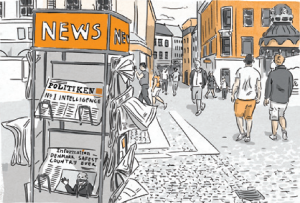Exploring challenges to press freedom across Europe
 A new graphic novel exploring challenges to press freedom across Europe and the impact of limitations on journalists has been released by the European Youth Press.
A new graphic novel exploring challenges to press freedom across Europe and the impact of limitations on journalists has been released by the European Youth Press.
Free Our Media is the result of a collaborative effort over the course of several months by a team of young journalists and illustrators assembled from all over Europe by European Youth Press, and contains 14 comics, each story centred on the state of media freedom in a different country. The project was funded by the Council of Europe.
Planning for Free Our Media started in autumn of 2014, when the European Youth Press team began outlining which media advocacy issues the organisation would focus on in 2015. Press freedom was high on the list of priorities, given its recent deterioration in the EU and neighbouring countries, and the organisation’s resolve to tackle this particular issue was only heightened by the violent attacks on satirical French newspaper Charlie Hebdo in January 2015. The visual medium of the graphic novel was chosen in order to make the content more universal across borders and language barriers.
 “A written article would get shared by an audience that is already familiar with the topic of press freedom,” said European Youth Press board member and Free Our Media project coordinator Anna Saraste. “In the comic book, we communicate the topic with a visual medium that appeals to a broader public.”
“A written article would get shared by an audience that is already familiar with the topic of press freedom,” said European Youth Press board member and Free Our Media project coordinator Anna Saraste. “In the comic book, we communicate the topic with a visual medium that appeals to a broader public.”
Creating the graphic novel was a challenge from start to finish, not least because of the distance between the participants. The journalists, who are aged between 18 and 35 and collectively dubbed Media Freedom Ambassadors, met twice before the final workshop. During these events, the group developed tools for actively addressing limitations to press freedom. They also had the opportunity to organise events within their own communities, which allowed them to gather input from other journalists and young media makers about press freedom and its value in society.
Months of work culminated in Berlin in July 2015. During a five-day workshop led by artists Yorgos Konstantinou and Marcos Mazzoni, the group of journalists met with the cartoonists and, in pairs, planned the storylines for each comic. Following the end of the workshop, the group worked on their pieces separately, and kept each other updated on their progress via Facebook and Skype, said Jo Breese, a British illustrator and Sunday Times graphic artist who was selected as one of the cartoonists for Free Our Media.
“You can draw silly cartoons about serious matters, and it helps, and it gets the message across,” Breese said. “And I think that was important for a lot of the people who were there, whose countries don’t have very good press freedom. It gave them a platform to say what they wanted to say.”
The book’s varied stories and illustration styles made the creation of a cohesive graphic novel another significant challenge. The solution devised by the team was a common color scheme throughout, comprised of various shades of white, black, and orange.
The completed graphic novel was officially released at the European Youth Media Days that took place in the European Parliament in Brussels from 20-22 October. Because the European Youth Press is a non-profit organisation, they must rely on donations to print, but soon hope to be able to start selling copies of the book online. While the book itself is a valuable tool for combating limitations on press freedom in Europe, Saraste is quick to emphasise that the real agents of change are young media makers.
“I wouldn’t focus so much on the book. I think what will be impacted for a long time are the ambassadors,” she said. “I think a lot has changed for them in terms of how they see their role as young media makers. Something in their attitude changed. They will have an impact on other people, wherever they go and wherever they decide to practice this profession.”
Following the completion of Free Our Media, the Media Freedom Ambassadors are continuing their activism by blogging for Index on Censorship’s Mapping Media Freedom project, to which they will contribute reports about their own countries and act as references for the site.
You can preview the graphic novel here.
This article was published on 26 November 2015 at indexoncensorship.org


